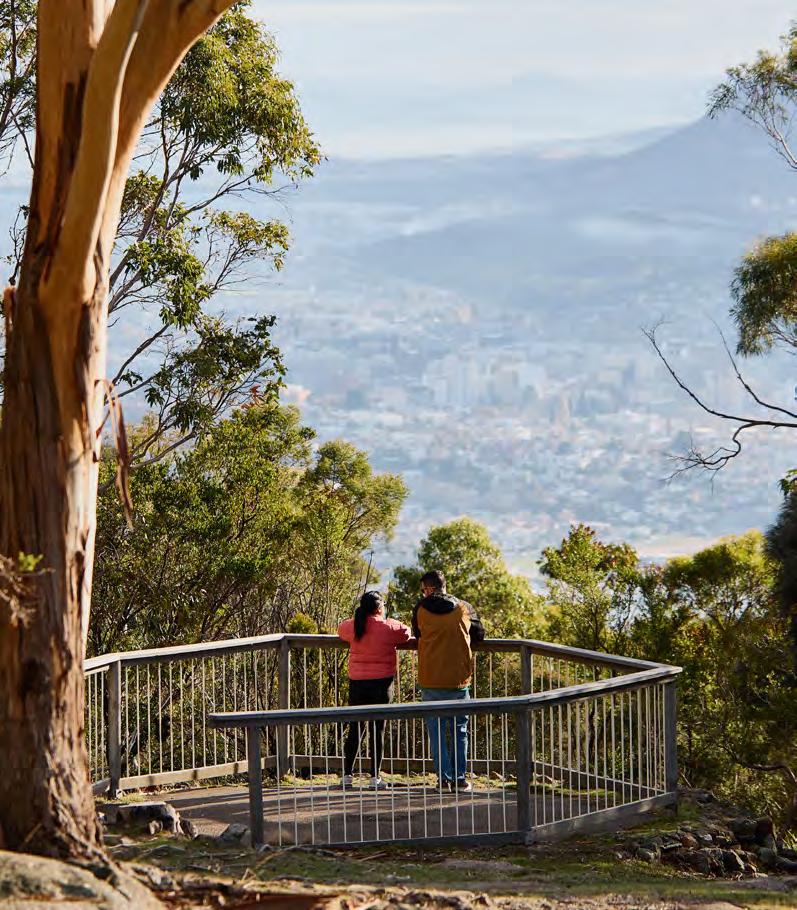
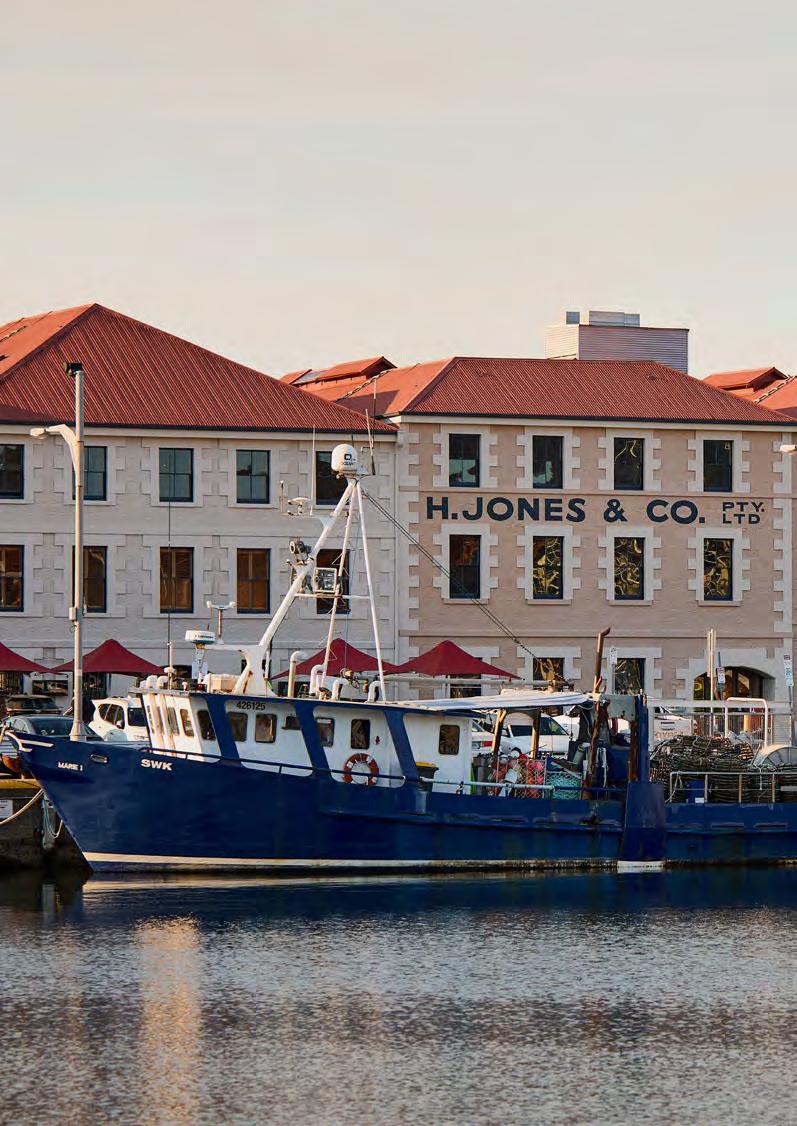

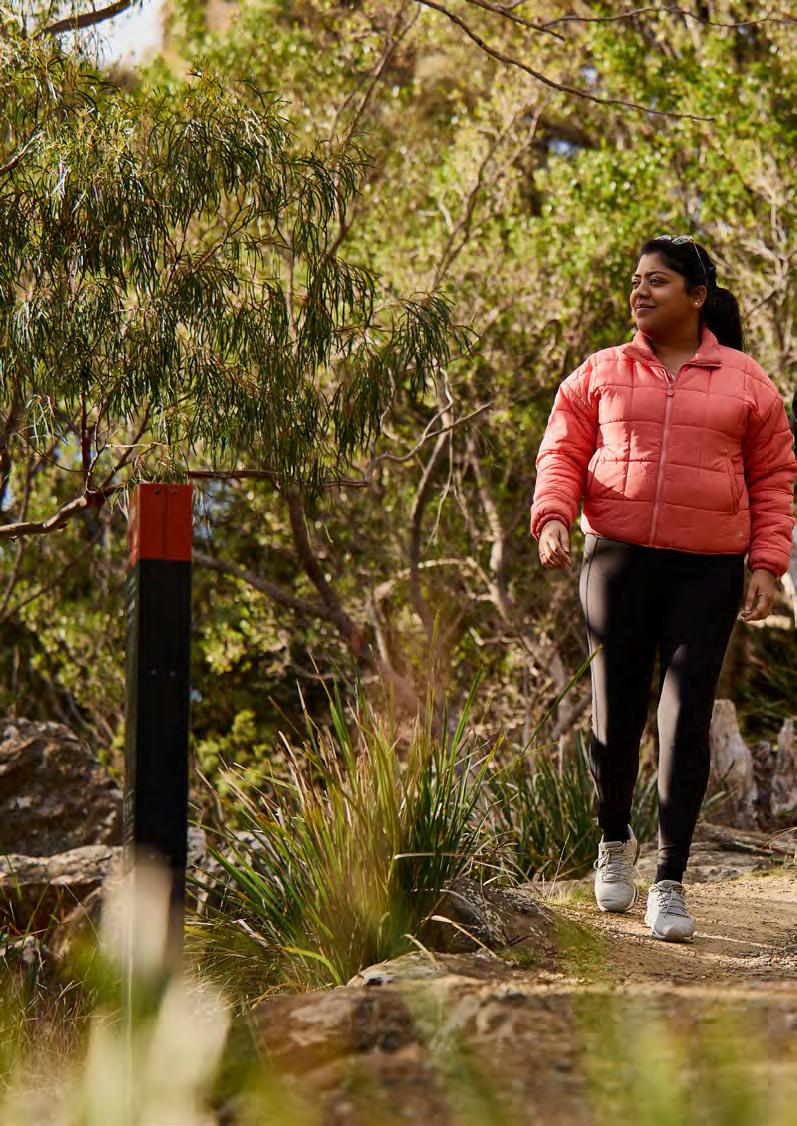





Hobart breathes.
Connections between nature, history, culture, businesses and each other are the heart of our city.
We are brave and caring.
We resist mediocrity and sameness.
As we grow, we remember what makes this place special.
We walk in the fresh air between all the best things in life.

Working together to make Hobart a better place for the community.
We care about people – our community, customers and colleagues.
We collaborate both within the organisation and with external stakeholders drawing on skills and expertise for the benefit of our community.
We have clear goals and plans to achieve sustainable social, environmental and economic outcomes for the Hobart community.
We embrace new approaches and continuously improve to achieve better outcomes for our community.
We are transparent, work to high ethical and professional standards and are accountable for delivering outcomes for our community.

In recognition of the deep history and culture of our city, we acknowledge the Tasmanian Aboriginal people as the Traditional Custodians of this land. We acknowledge the determination and resilience of the Palawa people of Tasmania who have survived invasion and dispossession and continue to maintain their identity, culture and rights. We recognise that we have much to learn from Aboriginal people today, who represent the world’s oldest continuing culture. We pay our sincere respects to Elders past and present and to all Aboriginal people living in and around Hobart.


It is with great pleasure that we introduce the City of Hobart’s Annual Plan for 2025–26.
The Plan serves as our compass for the next 12 months and we hope it will be another productive year of serving and achieving great results for our community.
Our core values—people, teamwork, focus and direction, creativity and innovation, and accountability—are exemplified by our staff to ensure that the programs and projects we deliver bring value and benefit to the community.
The Annual Plan outlines the directions, key actions, and initiatives that will shape our work for the upcoming year. It aligns with the Capital City Strategic Plan and our mission of Working together to make Hobart a better place for the community.
Our annual plan features 43 individual actions designed to guide the work of staff at the City of Hobart. These actions are not only innovative but also ensure ongoing financial viability. This balanced approach allows us to implement forward-thinking initiatives while maintaining the fiscal health of our city.
Some of our priorities and commitments over the next 12 months include:
• Developing the City’s first heritage strategy to provide clear guidelines in the management and preservation of Hobart’s unique historic buildings, homes and public spaces.
• Continuing the work we’ve done on our in-depth plan for closing, rehabilitating and repurposing the McRobies Gully Waste Management Centre by 2030.
• Developing and implementing waste reduction actions and programs to ensure the City’s objective of zero waste to landfill by 2030 is achieved.
• Continuing the development of the Mount Nelson and Sandy Bay Neighbourhood Plan, and delivery/implementation of the North Hobart Neighbourhood Plan.
• Designing and delivering a “Resilient Hobart” program to build community capacity to adapt to hazards (fire, flood, rising sea levels), as well as undertaking research and assessments to understand Hobart’s disaster risk more comprehensively and to identify actions we can take to manage these risks.
• Supporting Hobart households and businesses to be sustainable, emissionsconscious and to save money through an “Electrify Hobart” program which includes developing an effective and reliable electric vehicle charging network in the city.
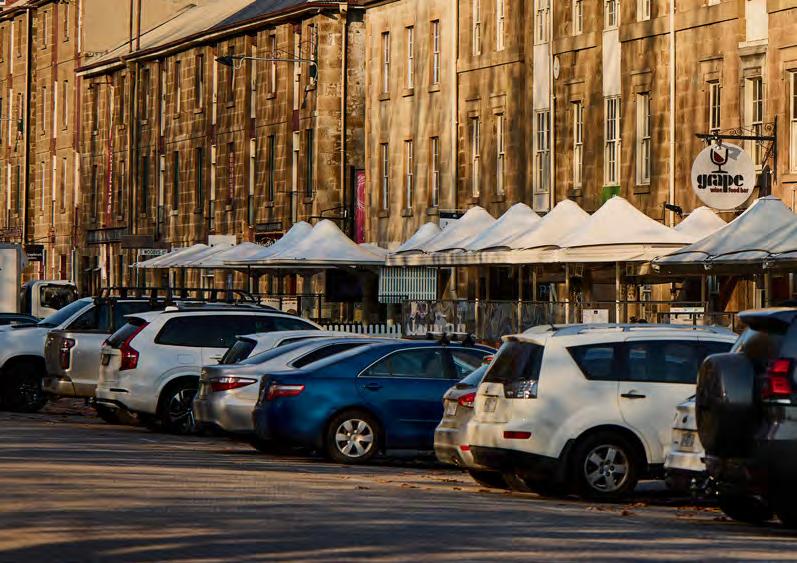
Importantly, during the year we will also be focused on several key strategic priorities including:
• Implementing a service review process to identify efficiencies and reduce costs.
• Cultivating a positive organisational culture with our leadership team.
• Protecting and enhancing Kunanyi/ Mount Wellington through active participation in the Tasmanian Government’s Strategic Review.
• Ensuring we are well governed through the development of a dedicated IT strategy.
• Enhancing our asset management practices.
• Maintaining financial sustainability and a fair rating system.
For 2025–26, we have budgeted for a modest rate increase of 3.5%, which is lower than what was predicted in our long-term financial management plan. We have worked hard to keep this as low as possible while still delivering on what our community expects and needs. In addition, because of prudent financial management, the full year budget forecast will result in a higher surplus than originally forecast in the long-term financial management plan.
All these projects have been prioritised to set our city up for long term success. This in addition to our $36.7 million capital works program which delivers playgrounds and open spaces, rivulet rewilding, roads and footpath maintenance, building and facilities upgrades, and plant and equipment renewal throughout the year.

The capital works program will include:
• Street tree planting
• Haigh Street pedestrian improvements
• Waterfront interpretation project
• Pump Track – South Hobart
• Queens Walk footpath
• Fire trail renewal
• Domain Athletic Centre track replacement
We are strategically refining our operations and the allocation of ratepayer funds to be a high performing, contemporary organisation that meets our community’s needs costeffectively, positioning us to create a sustainable city for the future.
By thinking holistically about our services and operations, we are ensuring that we can adapt and thrive in a dynamic environment, while upholding the standards our community
values. This commitment to excellence and efficiency helps us build a resilient and vibrant city for the long term.
We are looking forward to the opportunity to implement the strategic projects detailed in this document throughout the upcoming year.
Looking ahead, we are currently working on a 4-year delivery plan and a 10-year capital works program. As always, the juggle is getting the right balance between investing in community infrastructure and services at the time of need and increased demand while ensuring rates increases are sustainable and affordable for our community.
We are excited for another productive year delivering for the people of Hobart so that our city can continue to be a vibrant, prosperous and welcoming place for all.
Lord Mayor, Anna Reynolds
Michael Stretton, Chief Executive Officer
The City of Hobart Integrated Planning and Reporting Framework aligns our annual planning and reporting with performance evaluation and continuous improvement.
The Integrated Planning and Reporting Framework ensures that the Capital City Strategic Plan and Long-Term Financial Management Plan are put into action through the City’s Annual Plan and Annual Budget Program.

The 2025–26 Annual Plan sets out the major actions and initiatives for the City of Hobart for the financial year ahead. It is aligned with the Capital City Strategic Plan 2023, the Capital Works Program and other informing strategies.
The Plan demonstrates the capacity of the City of Hobart to achieve the strategies in the Strategic Plan which in turn reflects the aspirations of the community as expressed in Hobart: A community vision for our island capital.
The Annual Plan is required pursuant to section 71 of the Local Government Act 1993.
The Annual Plan is developed with the annual budget estimates and organisational plans, which identify the operational priorities for each function area.
The City has a number of key strategies that have been endorsed by the Council, these documents set the priorities for key actions in the Annual Plan. Some of these strategies include:
The Climate Ready Hobart Strategy is a guiding document to what the City of Hobart and the community can do together to respond to the climate and biodiversity emergency. Climate change is one of the most urgent and defining challenges of our time and it requires bold and immediate action from all sectors of society.
Despite the challenges, there are unprecedented opportunities to embrace innovative solutions through fostering a culture of sustainability. In 2025–26, the City of Hobart will continue to work towards achieving at least a 75 per cent reduction in organisational emissions by 2030. In addition to the identified Annual Plan actions, the City will commence the transition of the light vehicle fleet to electric vehicles and continue to increase the urban tree canopy.
The current City Economy Strategy leverages the strengths and opportunities of our City, while also considering the challenges, both now and into the future. The strategy defines our priorities, establishes outcomes and formalises the role of the City in the local economic development of Hobart.
An action in the 2025–26 Annual Plan will be to review the existing strategy to ensure alignment with economic trends, community aspirations and as part of building the world’s best small capital city.
In response to the growth of the Hobart population neighbourhood structure plans have been developed for Central Hobart and North Hobart, with plans also being developed for Mount Nelson and Sandy Bay and the Inner North-East.
They are evidence-based, future-focused plans that consider how a local area should develop and improve over time.
They consider things like existing and future housing needs, infrastructure and services, streets and public spaces, open space and greening, planning controls and future road and transport network requirements.
The Hobart Transport Strategy 2024 aims to support the development and implementation of an integrated climate ready and efficient transport and land use system for Hobart. It supports the objectives of existing Tasmanian Government, Greater Hobart and City of Hobart strategies.
The 2025–26 Annual Plan has a number of key actions to deliver in relation to the Hobart Transport Strategy 2024 including, providing publicly available transport data on all transport modes, developing a policy to support an electric vehicle charging network and developing the Hobart Bike Plan.
The Hobart Waste Management Strategy 2025 has been designed to underpin the behavioural change needed to ensure the City is able to achieve its waste reduction targets, including closing the McRobies Gully landfill site by 2030. This will enable McRobies Gully to be modernised to allow material recovery from Hobart’s waste stream. The new strategy also maps out key actions required over the next five years to allow the City of Hobart to embrace a circular economy and prepare for the closure of the landfill site.

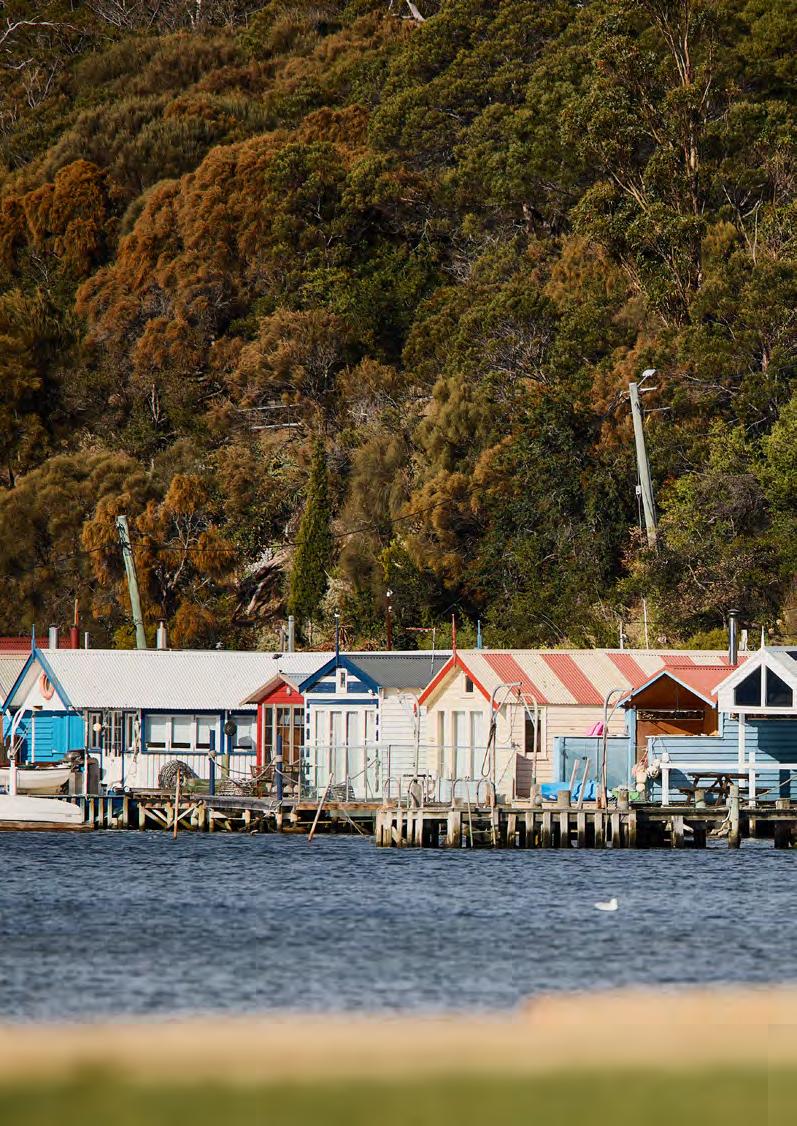

We are a city of unique beauty, environment, heritage and people, built on a shared sense of ownership, pride and wonder. This spirit of place has been shaped by Tasmanian Aboriginal people for tens of thousands of years and continues to be shaped by all who have called Hobart home. It is developed jointly by community, private enterprise and government, valuing and enhancing our Hobart identity.

1.1 Hobart keeps a strong sense of place and identity, even as the city changes.
1.2 Hobart’s cityscape reflects the heritage, culture and natural environment that makes it special.
1.1.1
6.1.1
Actively participate in the review of the governance arrangements and master planning for Kunanyi/ Mount Wellington and develop an agreed future direction and sustainable funding model.
1.2.2
7.3.4
Develop a streetscape improvement plan for Montpelier Retreat from Salamanca Place to Hampden Road.


We are an island capital city that is socially inclusive and coherently connected, whose people are informed, safe, happy, healthy and resilient.

2.1 Hobart is a place that recognises and celebrates Tasmanian Aboriginal people, history and culture, working towards shared goals.
2.2 Hobart is a place where diversity is celebrated and everyone can belong, and where people have opportunities to learn about one another and participate in city life.
2.3 Hobart communities are active, have good health and wellbeing and are engaged in lifelong learning.
2.4 Hobart communities are safe and resilient, ensuring people can support one another and flourish in times of hardship.
2.1.2
2.2.2
2.1.4
8.2.6
2.3.1
2.4.1
2.3.2
6.5.1
2.3.3
6.5.1
2.3.3
Implement the final stage of the Crowther Reinterpreted project.
Develop a First Nations Procurement Policy that supports the economic growth of First Nations businesses and employment opportunities for Aboriginal and Torres Strait Islander People.
Develop a Health and Wellbeing Strategy that sets the health priorities for the municipality, to prevent or reduce public health issues and support optimum community health and wellbeing.
Commence planning for the implementation of a master plan for the Hockey Centre, Cornelian Bay and Selfs Point.
Progress planning for the Selfs Point Basketball Stadium and continue to seek funding for its construction.
Develop, with the other Greater Hobart councils, a Greater Hobart Sport Facilities Strategy that informs planning for new and upgraded sporting infrastructure.


We are a city connected, embracing our diverse communities in cultural expression and creative and artistic participation; a city that enhances our homes, lifestyles and heritage; a city that bravely puts its people first.

3.1 Hobart is a creative and cultural capital where creativity is a way of life.
3.2 Creativity serves as a platform for raising awareness and promoting understanding of diverse cultures and issues.
3.3 Everyone in Hobart can participate in a diverse and thriving creative community.
3.4 Civic and heritage spaces support creativity, resulting in a vibrant public realm. Strategic Reference
Actions and Initiatives
3.1.1 Deliver and commence implementation of the Creative City Strategy.
3.4.1 1.2.2
Improve the public realm outcome in Bidencopes Lane to create a safe, accessible and evolving creative space.
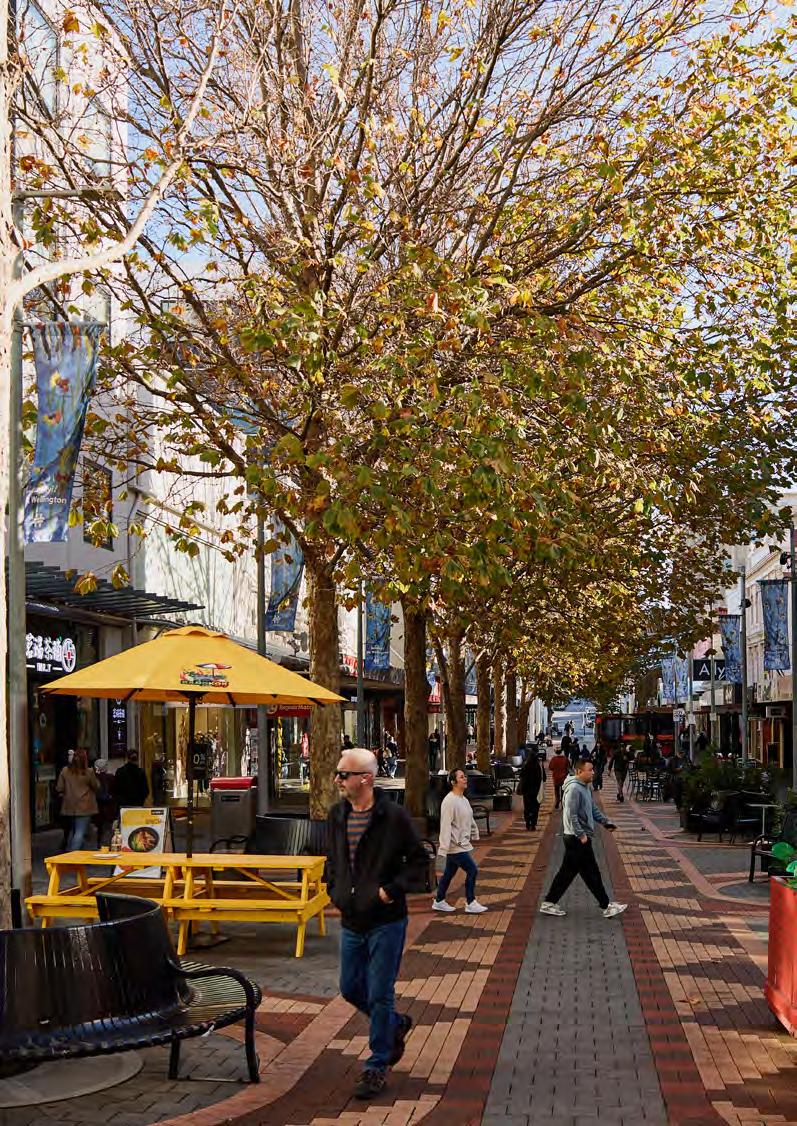

We are a city whose economies connect people, businesses, education and government to create a high-quality lifestyle in a thriving and diverse community. Our city is our workshop. We collaborate, embracing ideas, inventiveness and initiative.

4.1 Hobart’s economy reflects its unique environment, culture and identity.
4.2 Diverse connections give people opportunities to participate in the economic life of the city and help the economy, businesses and workers thrive.
4.3 Hobart is a place where entrepreneurs and businesses can grow and flourish.
4.4 Hobart’s economy is strong, diverse and resilient.
4.1.1 Work with partners to design and implement an investment attraction strategy for the Hobart Innovation Precinct that supports delivery of Strategy 3.1 of the Central Hobart Plan.
4.4.1 Review the City’s Economic Development Strategy to ensure alignment with economic trends, community aspirations and as part of building the world’s best small capital city.


We are a city where everyone has effective, safe, healthy and environmentally friendly ways to move and connect, with people, information and goods, and to and through spaces and the natural environment. We are able to maintain a pace of life that allows us to fulfil our needs, such as work, study, business, socialising, recreation, accessing services, shopping, entertainment and spending time with loved ones.

5.1 An accessible and connected city environment helps maintain Hobart’s pace of life.
5.2 Hobart has effective and environmentally sustainable transport systems.
5.3 Technology serves Hobart communities and visitors and enhances quality of life.
5.4 Data informs decision-making.
5.1.1
5.2.2
5.1.1
5.2.7
Undertake community engagement to inform the Mount Nelson Local Area Mobility Plan.
Engage with relevant stakeholders to progress the concept design for the potential establishment of a shared accessway around the Battery Point Foreshore linking Marieville Esplanade with Sullivans Cove.
5.1.3
5.1.4
5.1.4
5.4.1
5.2.1
5.3.1
5.2.2
5.4.1
5.2.2
5.2.5
Finalise design and undertake the construction of three new passenger ferry terminals located at Lindisfarne, Wilkinson’s Point, and Sandy Bay, on behalf of the Greater Hobart councils.
Provide publicly available transport data on all transport modes; driving, riding and walking.
Develop a policy to support an effective and reliable electric vehicle charging network and initiate mapping of charging infrastructure in partnership with the private sector and government.
Work with stakeholders to monitor the Collins Street streetscape design and report back to Council at the first month, third month and 12 months stages on the success of the project against the evaluation framework.
Develop the Hobart Bike Plan following engagement with stakeholders.
Commence research and engagement for the development of The Future State of Parking Report that explores and guides how on- and off-street parking will evolve in Hobart between 2027 and 2037.
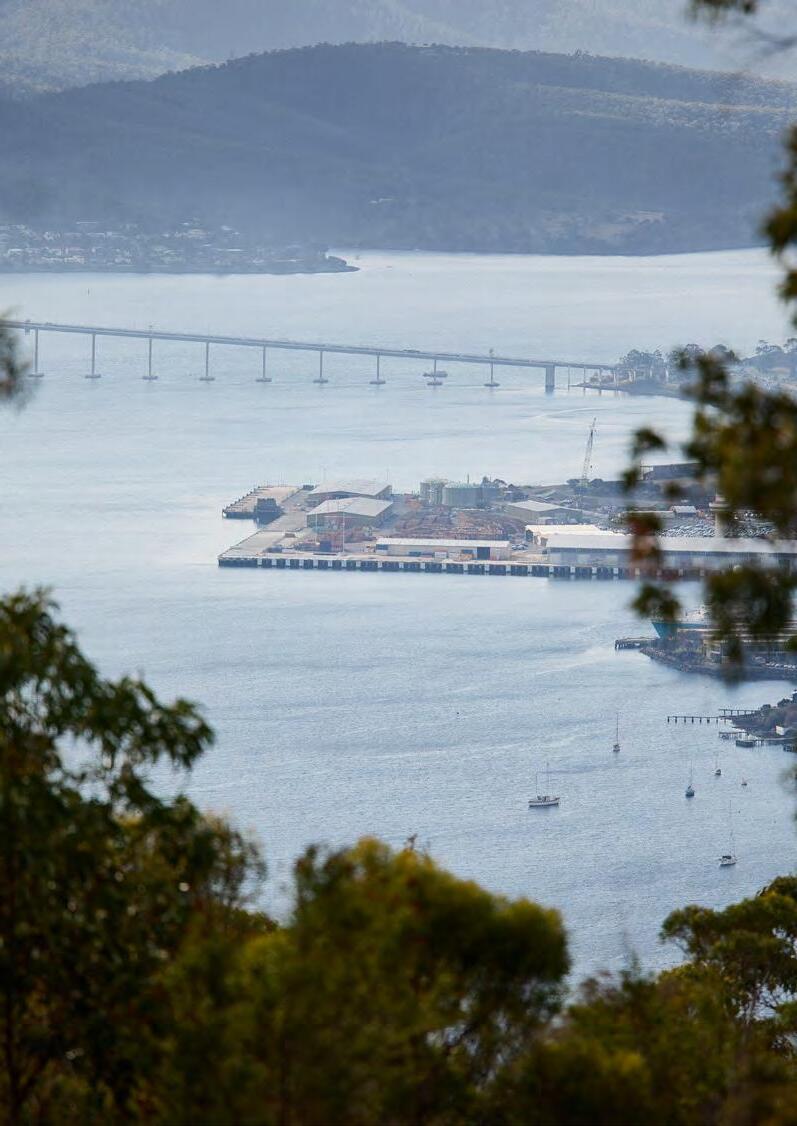

We are a city whose people see ourselves as part of a beautiful and unique natural environment, from the mountain to the river, which embrace us and shape our identity. We are proud custodians and advocates, ensuring resources are appreciated rather than wasted, supporting biodiverse ecosystems in honour of past, current and future generations.
6.1 The natural environment is part of the city and biodiversity is preserved, secure and flourishing.
6.2 Education, participation, leadership and partnerships all contribute to Hobart’s strong environmental performance and healthy ecosystems.
6.3 Hobart is a city supported by ecologically sustainable waste and water systems.
6.4 Hobart is a leader on climate change moving toward a zero emissions and climate-resilient city.
6.5 Hobart’s bushland, parks and reserves are places for sport, recreation and play.

6.1.1
Commence the development of a masterplan for a visitor and transport hub at Halls Saddle that informs the future use of the site to disperse visitation and ease congestion at the Springs and the Pinnacle.
6.1.6
6.4.3
6.1.6
6.1.6
Finalise the Urban Tree Strategy.
Develop and implement a program to accelerate tree planting across the city in the financial year towards the urban canopy goal of 40% canopy cover by 2046.
Develop a program to enhance urban greening on private land, including education, promotion and giveaways.
6.3.1 Further develop the plan for the closure, rehabilitation and repurposing of McRobies Waste Management Centre.
6.3.3 Undertake an audit of current water sensitive urban design features and develop a plan to enhance their effectiveness.
6.3.3 Identify a trial site for water sensitive urban design treepits.
6.4.1
6.4.2 1.1.4
6.4.6 1.1.4
Design and deliver an ‘Electrify Hobart’ program to support households and businesses to be zero emissions, reduce costs and improve health.
Design and deliver a ‘Resilient Hobart’ program to build the community’s capacity (including vulnerable populations) to adapt to all hazards (fire, floods, heat and sea level rise etc) through increased knowledge, social connection, and wellbeing opportunities.
Undertake an Integrated Hazard Vulnerability Assessment to consolidate and address gaps in spatial hazard and vulnerability data, with a specific focus on flood risk, to comprehensively understand Hobart’s disaster risk, how it will shift with climate change, and identify actions to manage these risks.
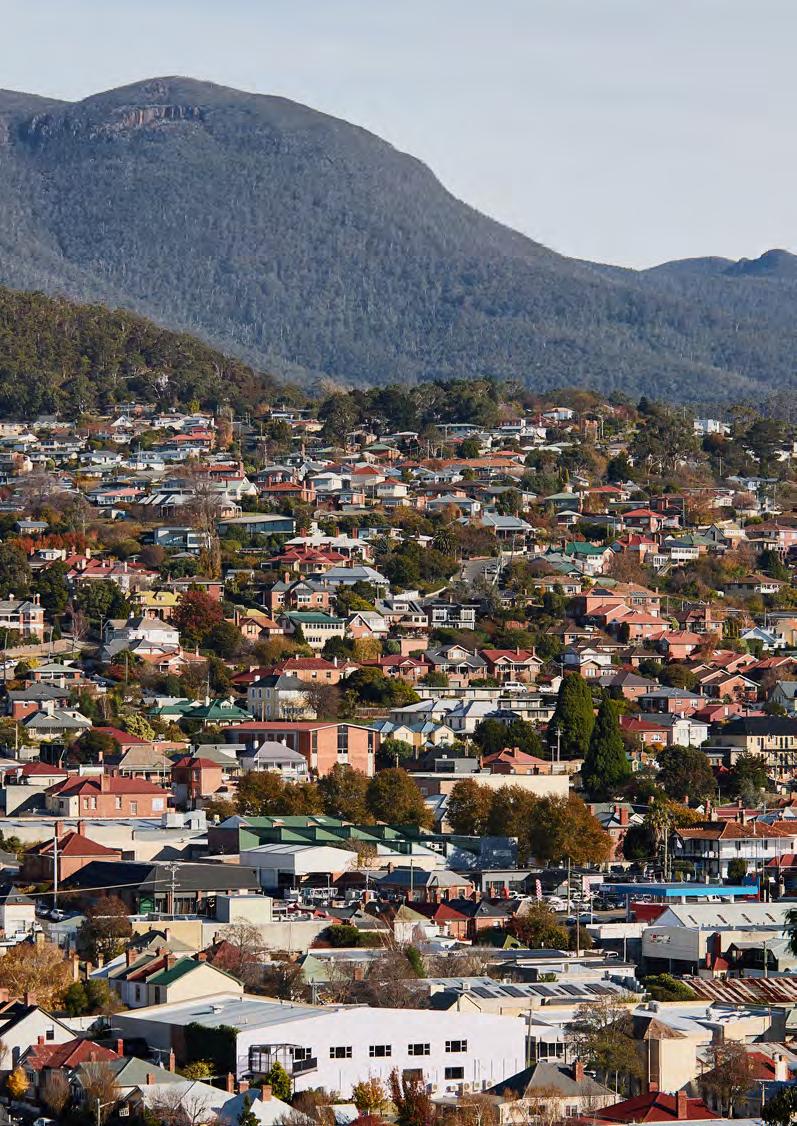

We are a city that maintains our unique built and ecological character, where we all have a safe, secure and healthy place to live. We are a city where people and communities can access world-class services and infrastructure and provide for their social, cultural and economic wellbeing. We embrace change but not at the expense of our Hobart identity and character.

7.1 Hobart has a diverse supply of housing and affordable homes.
7.2 Development enhances Hobart’s unique identity, human scale and built heritage.
7.3 Infrastructure and services are planned, managed and maintained to provide for community wellbeing.
7.4 Community involvement and an understanding of future needs help guide changes to Hobart’s built environment.
7.1.1 Finalise the Hobart Housing Action Plan to support the housing sector, in collaboration with the state and federal government, to meet the urgent and growing needs of our community, expanding on the City’s Affordable Housing and Homelessness Commitment 2021–23.
7.2.6 1.2.1
Develop a Heritage Strategy that protects Hobart’s character and heritage values and informs the Heritage Design Guidelines.
7.3.2 Commence a review of the long-term Strategic Asset Management Plan and develop and implement Asset Management Policies, Strategies and Plans that fully integrate and are aligned with the City’s strategic objectives, finances, and direction.
7.3.3 Review the draft City Hall Masterplan and develop an action plan to address operational issues and increase activation of the Hall and its surrounds.
7.3.3 Engage with relevant stakeholders to design and redevelop the Hobart Council Centre, Town Hall Annex and Civic Square.
7.4.3 Collaborate with the state government and other southern councils in the review of the Southern Tasmania Regional Land Use Strategy.
7.4.4 1.2.4
7.4.4 1.2.4
Develop an implementation plan for the delivery of the North Hobart Neighbourhood Plan.
Continue the development of the Mount Nelson and Sandy Bay Neighbourhood Plan.


We are a city of ethics and integrity. We govern with transparency and accountability, encouraging and welcoming active civic involvement. We collaborate for the collective good, working together to create a successful Hobart.

8.1 Hobart is a city that is well governed that recognises the community as an active partner that informs decisions.
8.2 Hobart is a city that delivers public value and excellence by being a financially responsible, high performing and accountable organisation that it responsive to the needs of the community.
8.2.1 Investigate a new funding mechanism for attracting philanthropic funding for City and community priorities.
8.2.3 Develop a City of Hobart Security Plan that improves organisation-wide clarity on the ownership of physical security, assets and policies.
8.2.3 Develop an IT Disaster Recovery Plan that prepares for and responds effectively to unexpected events, safeguarding critical data, maintaining business operations, and protecting the overall health of the organisation.
8.2.3 Improve the organisations cybersecurity to predict, prevent and respond to cyber threats.
8.2.5 Undertake the mid-term review of the City's Rating and Evaluation Strategy 2024–28.
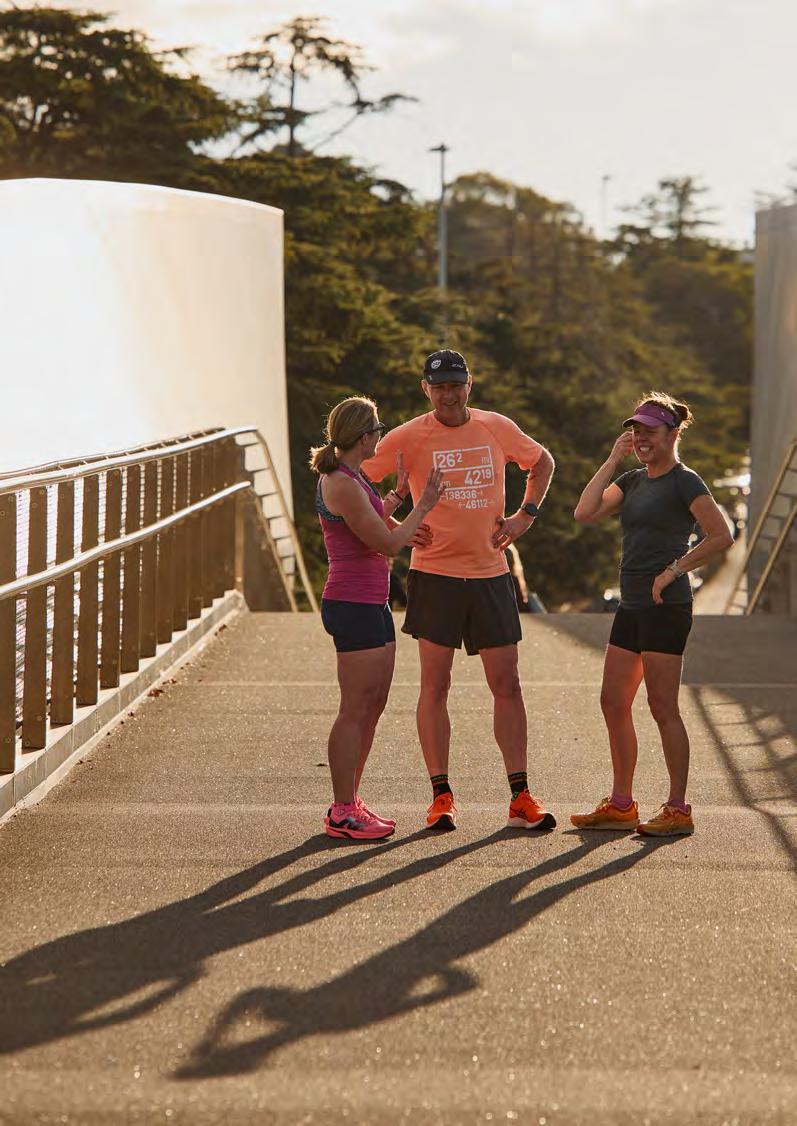

Section 71(2)(d) of the Local Government Act 1993 requires the City of Hobart’s Annual Plan to include a summary of the major strategies to be used to achieve the City’s public health goals and objectives. The City of Hobart’s commitment to maintaining high levels of public health protection is identified under Pillars 2 and 6 of the Capital City Strategic Plan 2023:
Hobart communities are safe and resilient, ensuring people can support one another and flourish in times of hardship.
Strategy – 2.4.1
Protect and improve public and environmental health, wellbeing and safety.
Strategy – 2.4.2
Ensure that Hobart is a safe and liveable city by enhancing community wellbeing and public safety and security.
The natural environment is part of the city and biodiversity is preserved, secure and flourishing.
Strategy – 6.1.5
Regulate, measure and manage potentially polluting activities, prioritising air and water quality.
Actions for 2025–26 are:
Develop a Health and Wellbeing Strategy that sets the health priorities for the municipality, to prevent or reduce public health issues and support optimum community health and wellbeing.
These actions are undertaken by the Environmental Health Unit of the Community and Economic Development Network.
Pursuant to the Local Government Act 1993, the Council is required to prepare estimates of its revenue and expenditure for each financial year. The estimates must be adopted by an absolute majority of the Council before 31 August.
Some of Council’s cash reserves are restricted. In some cases, this restriction is imposed by legislation (e.g. The Heritage Account). Others have been earmarked for certain purposes by Council decisions and may therefore be used for other purposes at Council’s discretion.
At its meeting to approve the Annual Estimates, the Council approved the delegation of power to expend monies to all the Council committees and the Chief Executive Officer. The power to expend monies was linked to the delegation categories shown below.
The delegation categories are defined as follows:
Delegation 1: power to expend monies delegated to the Chief Executive Officer. Pursuant to the Council resolution and further pursuant to section 64 of the Local Government Act 1993, the Chief Executive Officer is authorised by the Council to delegate this power to Council employees.
Delegation 3: power to expend monies reserved to the Council.
The expenditure of money within all budget functions listed in the Annual Plan are Delegation 1.